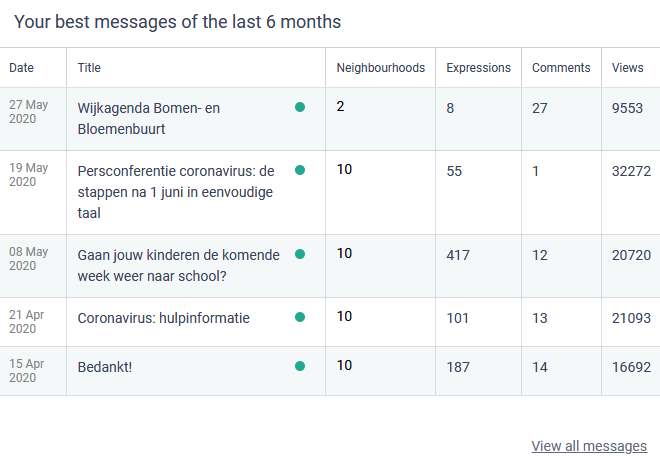The Hague: case study and details of a Hoplr community building pilot
In 6 months time, over 4,100 households (12%) have registered in the 10 neighbourhoods that were selected for the Hoplr pilot in The Hague. Neighbours post an average of 100 messages and 730 comments per week, counting for a total of 66,000 interactions. 72% of the registered households visit Hoplr at least once per week.
In this article, you’ll read:
- What the City of The Hague hoped to achieve with this Hoplr pilot
- How a Hoplr pilot works
- What the results have been after 6 months
1. The Hague’s goal for the Hoplr pilot
The City of The Hague’s ambitions for the Hoplr-project were twofold:
- The Hague wanted to measure the impact of local community building in some of their neigbhourhoods to increase social cohesion, inclusion, home and community care and involvement among neighbours.
- The Hague wanted to experiment with the citizen participation and communication functionalities of our Service Dashboard.
“We connect neighbours with each other and with their local government.”
Hoplr shifts the focus from the individual to the community. Via Hoplr you get easy access to the social capital in your neighbourhood such as material, knowledge, time and infrastructure.
- Phase 1. Connect online, meet offline.
Hoplr enhances social cohesion among neighbours by stimulating offline encounters. For example: requests for help, exchanging goods and services, local activities and circular economy.
- Phase 2. Observational learning and reciprocity.
We stimulate the neighourhood to become gradually more caring and inclusive. We do this by creating a ripple effect of observational learning where one case of help can inspire others, and by focusing on what people in need of help can contribute to the community. - Phase 3. Community building creates a sense of belonging.
Once a local community establishes a strong sense of involvement and responsibility, it starts to take care of itself and members will guard its integrity. They will actively look to include people such as elderly, newcomers and non-native speakers. This is the perfect breeding ground for meaningful citizen engagement and participation.
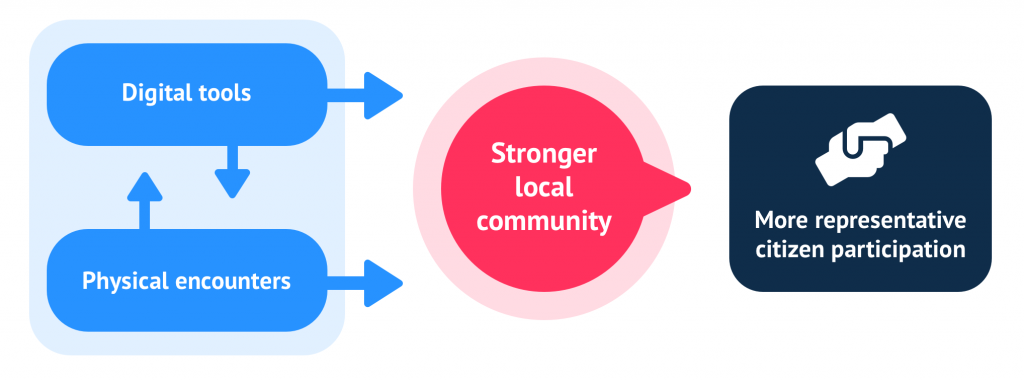
There is no program and there is no service for loneliness. The only way that we can address loneliness, is by building community, by building deep relationships.
Cormac Russell
Read more about the social impact of Hoplr.
2. How does a Hoplr pilot work?
A Hoplr pilot allows local governments to temporarily try out the Service Dashboard for 6 months at a fixed pilot cost, without any further commitment.
Step 1: Determining neighbourhoods
- Together with the client we divide the selected region into neighbourhoods. Ideal neighbourhoods consist of 1000 to 4000 households and often comprise a city district, a city center, a residential area, a village, …
- We draw up a physical invitation letter with the logo of your organisation. This invitation letter has a code that allows citizens to sign up for the correct neighbourhood based on their address.
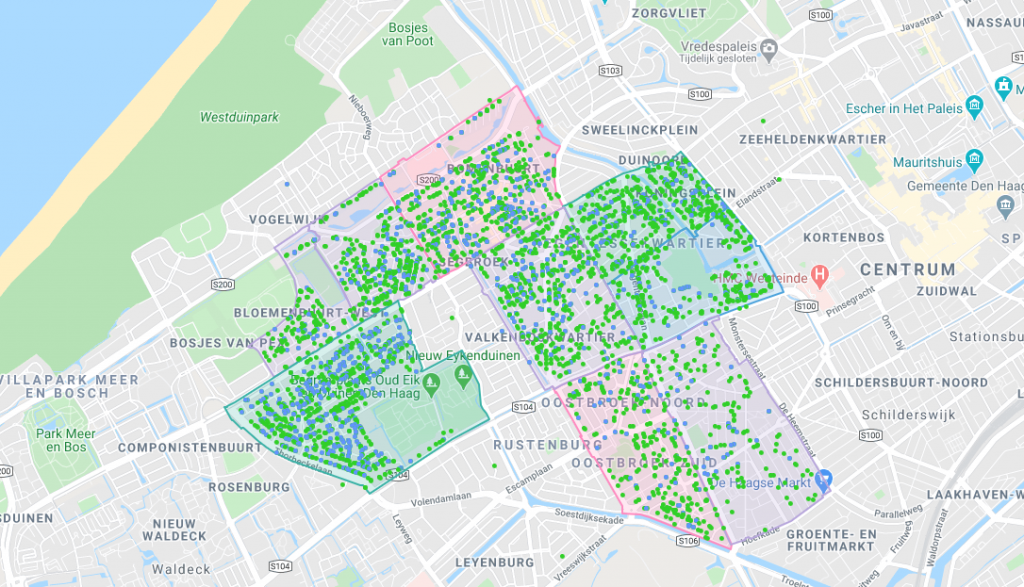
Blue – organic signups without code
Step 2: Distribution of the invitation letter
There are several options regarding the distribution:
- We could call on some volunteers or committed citizens who are keen to connect the neighbourhood and distribute the invitation letters.
- We can contact one or several local organizations that are willing to deliver the invitation letters per neighbourhood in exchange for a fair compensation. This way, a considerable share of the fixed pilot cost flows right back to the community.
- We may come up with an alternative, perhaps relevant to your country. Consider what party delivers any local info magazines you may be publishing, or if there are any sheltered workshops around that could help.
- We pay a local distribution company to do deliver the letters.
Step 3: Start use of the Service Dashboard
During an online information session, we’ll show you the ropes of the Service Dashboard.
We’ll kick off with a first status update on the Hoplr neighbourhoods (how many households are registered, how active are they on the network, how is the network being used,…).
Then, we’ll show you the different modules of the Service Dashboard and how you can use it for citizen communication and participation.
Finally, we’ll inspire you with some communication examples from other cities and set you up with a first message to post in the connected Hoplr neighbourhoods.
Whenever applicable, the process starts with the localization of our platform. We collaborate with native speakers to translate and adapt the social network, help pages, dashboard, and blog to the regions at hand.
Today, Hoplr and the Service Dashboard are available in Dutch, French and English. Hoplr is perfectly suitable for bilingual regions, as the Hoplr-neighbourhoods in Brussels have shown.
3. Results of Hoplr pilot in The Hague
After six months, over 4,100 The Hague households have registered, which equals to 12% of the selected neighbourhoods. On average, 312 new households register each month still, which shows a continued organic growth.

Interaction between citizens
Citizens have posted 10,125 messages so far, and are continuing to post 100 neighbourhood messages and 730 reactions every week. 72% of users come back every single week. And 70% have actively contributed to the conversation, whereas others have merely followed so far. All together, Hoplr has caused 66,000 interactions of all kinds between The Hague citizens. This means an average of 16 interactions per household.

Not just online, Hoplr stimulates offline interactions as well. This much we can tell: users have organized 181 neighbourhood activities, to which 623 neighbours responded they were interested and 239 said they would attend.
A poll showed that 59% of users from The Hague had already met at least one neighbour because of Hoplr. People responded with some examples of why they met: because they helped hang up a lamp, because they were looking for a refrigerator and because some game nights were hosted in the neighbourhood.
Messages mainly revolve around circular and local economy, contact with neighbourhoods, and ecology – however, these hot topics are different for every Hoplr neighbourhood. Our Service Dashboard uses AI to determine the topic of each message. This way, The Hague can collect a lot of interesting data, without having to access any of the Hoplr neighbourhoods or the conversations that take place there.
Before too long, I noticed more connectedness. I sometimes worry that people who move from the physical to the digital domain, may become isolated. Here I saw the opposite happening. Online messaging turned into recognition and conversations in the streets.
Eric Borst, Community building Municipality of The Hague
From citizens to government
Not only can members of the local communities direct their messages to each other, but to the staff of the City of The Hague as well. These are bottom-up messages.
Citizens can use this option, either to make a report (The Hague example: dangerous cracks in the pavement) or to share an idea (The Hague example: initiatives to make the streets greener).
So far, citizens have shared 40 bottom-up reports (21) and ideas (19) with the local government of The Hague.
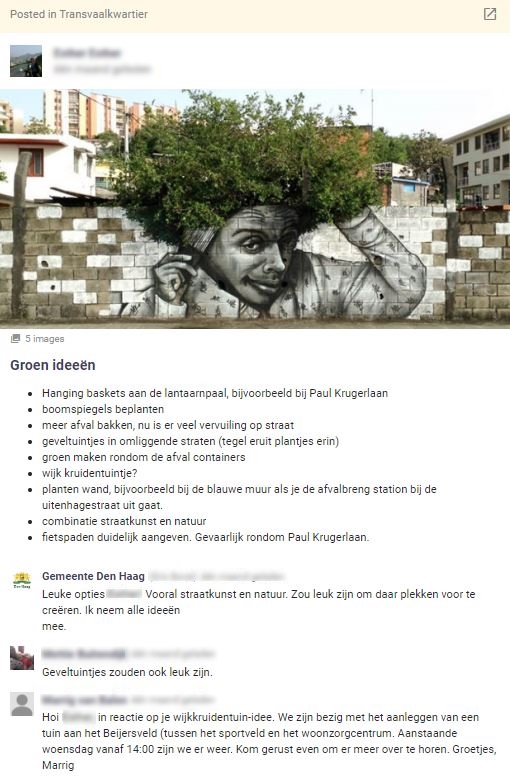
A resident of ‘Transvaalkwartier’ in The Hague shares their ideas to make the neighbourhood greener: baskets on street lanterns, a shared neighbourhood herb garden, facade gardens, combining street art and nature, … The Hague government responds that the ideas are fun, especially the one about street art, and that they’ll revise them internally. Another person responds that they’re working on a shared garden and that the original poster is welcome to join.
From government to citizens
Finally, the local government of The Hague can use Hoplr for citizen participation and communication. As such, users of the Service Dashboard (staff of the city, county, municipality,…) can post several types of messages and participation projects. Among which alerts, events, surveys, and much more.
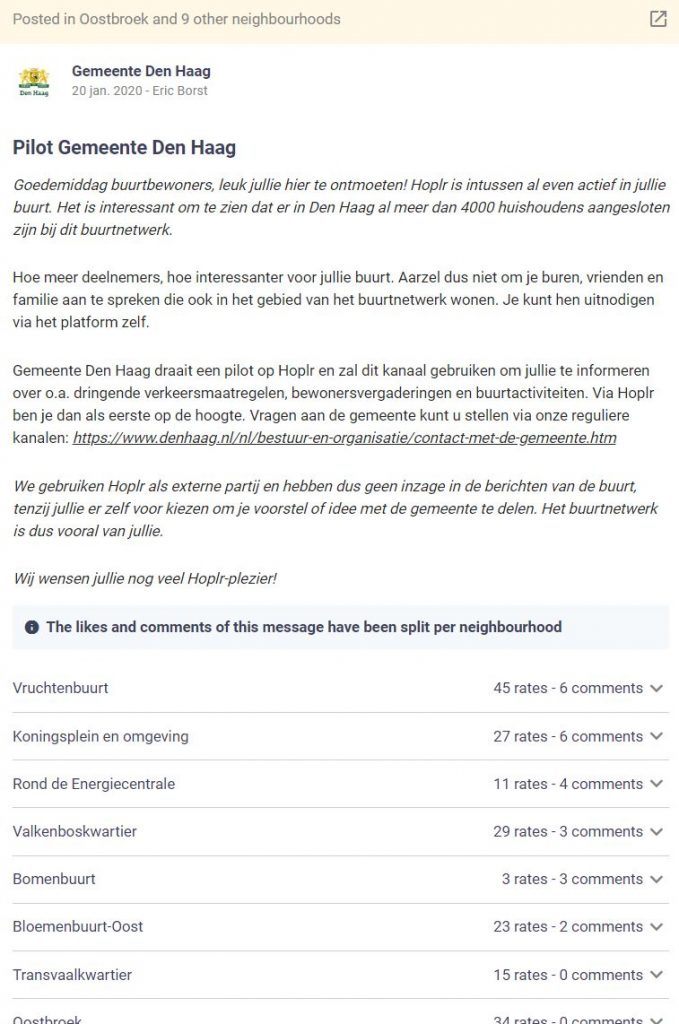
The government of The Hague publishes its first message in the Hoplr neighbourhoods: “[…] The municipality of The Hague will use this channel to inform you about traffic measures, city meetings, neighbourhood activities, etc. Via Hoplr, you will be the first to find out any info relevant to the neighbourhood. […] ”
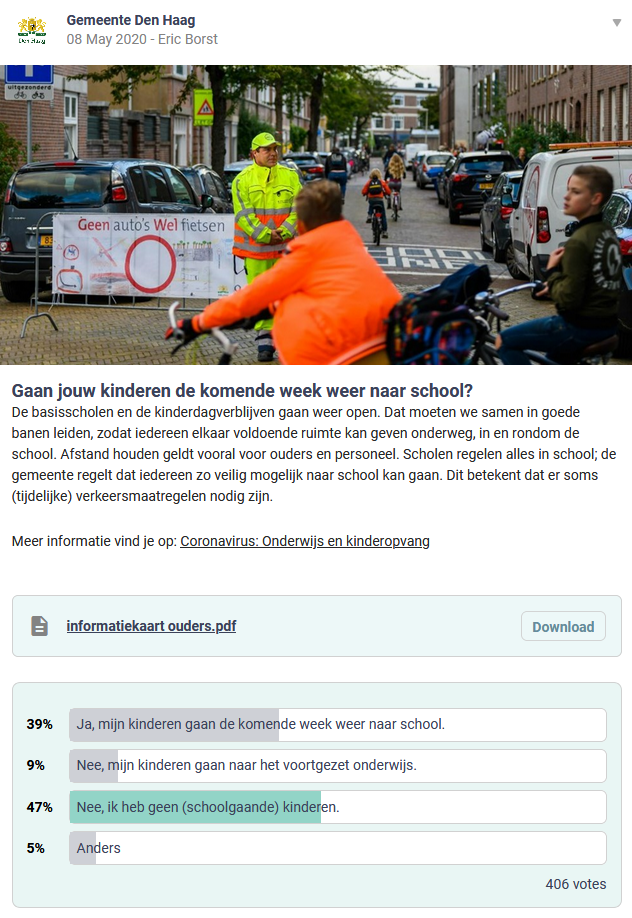
The Hague publishes a poll asking if Hoplr users’ children will be returning to school, once measures against the coronavirus allow them to.
So far, the local government of The Hague has shared 10 messages with its citizens. Among others, they have used the Hoplr Service Dashboard to communicate about the corona virus and a participation project concerning ecology.
